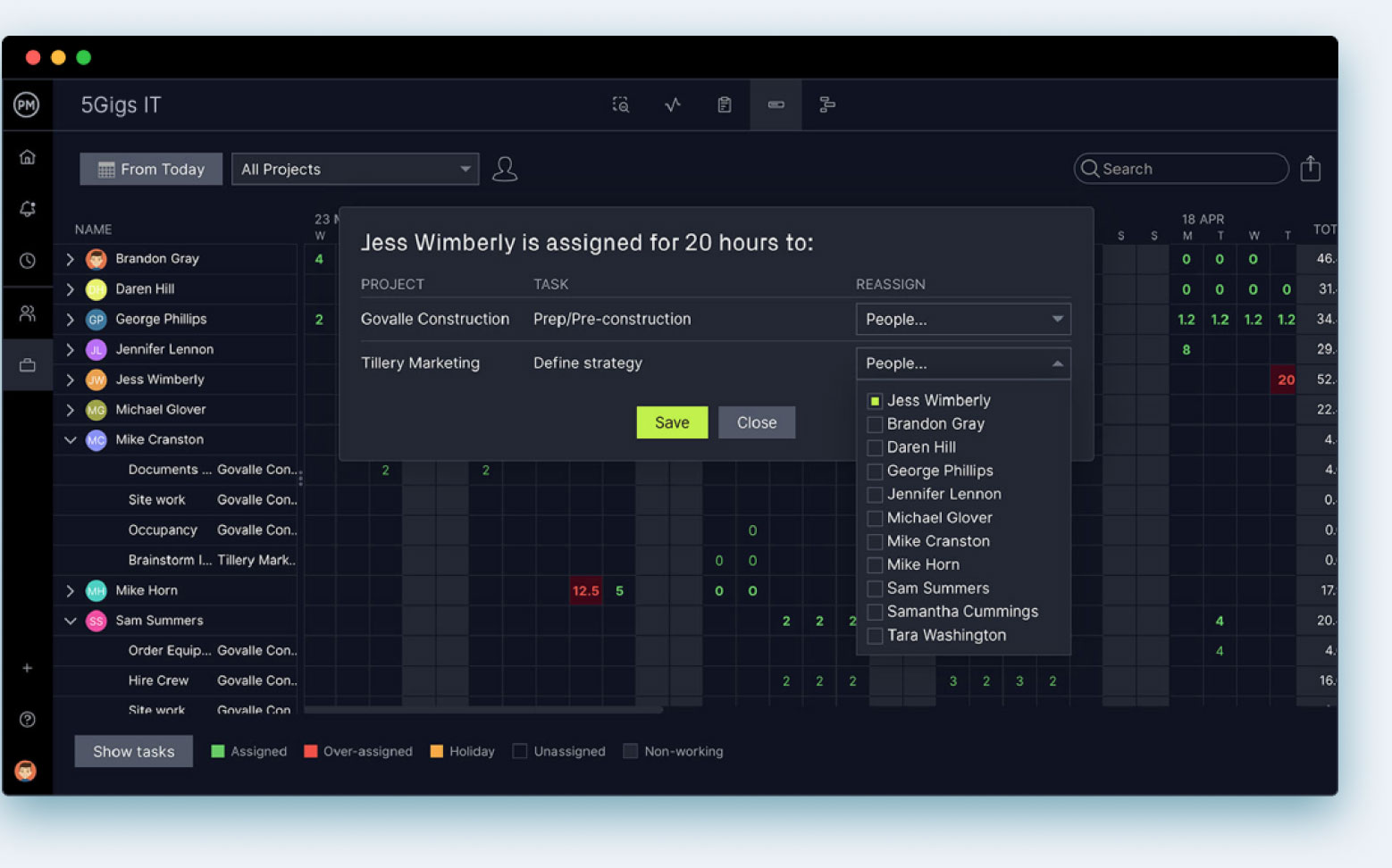Project managers are constantly making requests to the project management office (PMO). That’s normal. However, problems occur when requests are submitted without a standardized process. There shouldn’t be many ways to receive requests. To avoid that, you need an intake process.
A project intake process is beneficial for an organization. We’ll explain why as well as what to look out for when evaluating those project requests. We’ll also outline the project intake process, what should be included and who’s responsible for overseeing the process.
What Is the Project Intake Process?
The project intake process is a way to standardize the steps involved in requisition, assessing and accepting, declining or deferring incoming requests or new projects. It’s used by PMOs to manage the requests they get from the many projects they’re overseeing.
The process usually begins when a project initiator completes a project intake request form. This is then reviewed for the relative merits of the project being proposed. Having a single entry point for these requests is the best way to capture key information and fully understand the costs, benefits and impact of the project proposal before committing to it.
PMOs can use project management software to review and decide on whether to accept, reject or defer the request. ProjectManager is award-winning project management software that estimates project costs and creates budgets to show the viability of the request. Our Gantt charts allow you to organize tasks and their associated resources and costs to build a budget. You can even filter for the critical path to identify essential tasks and determine if the project is worth initiating. Get started with ProjectManager today for free.
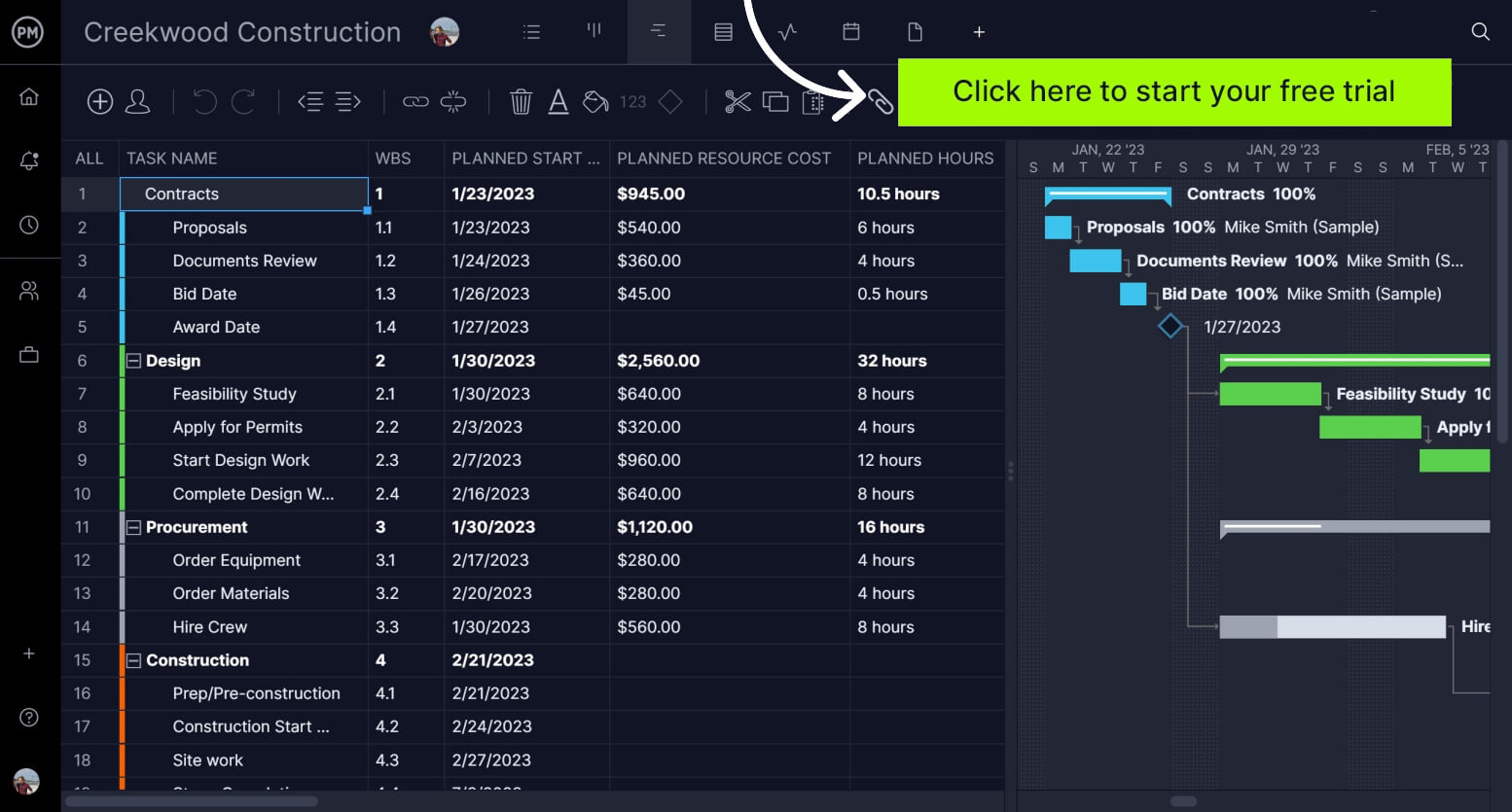
Benefits of Establishing a Project Intake Process for Your Organization
Having a system to respond to requests is advisable and better than letting them pile up haphazardly. Project portfolio management is all about efficiency, after all. A PMO is setting the tone for how projects are managed and should structure its activities as they demand projects. Let’s dive into the benefits of the project intake process to further illustrate its importance.
Helps Allocate Organization’s Resources for the Most Important Projects
Organizations run projects and expect those projects to participate in achieving their strategic goals. But there are only so many resources in which to do this and, therefore, the PMO must prioritize projects. This strategic alignment of projects requires allocating resources to those projects that are most important. Having a project intake process allows the PMO to access each request efficiently and effectively so they can serve that organizational goal.
Defines a Criteria for Project Selection
Standardizing the project intake process, such as having a form that’s always used, collects the same information for every possible project and lets the PMO not only compare apples to apples but quickly define the criteria for which project they feel is the best fit for the organization through cost-benefit analysis.
Brings Visibility to the Project Prioritization Process
A project intake process also increases visibility within an organization. You don’t want work that isn’t being tracked or ad hoc projects or programs that are being done in isolation.
This also helps decision-making as the decision-makers are clear on all aspects of what they’re making decisions on. The reasons for a project getting priority are understood by the whole organization, which can reduce conflict as teams from different projects know why resources were allocated.
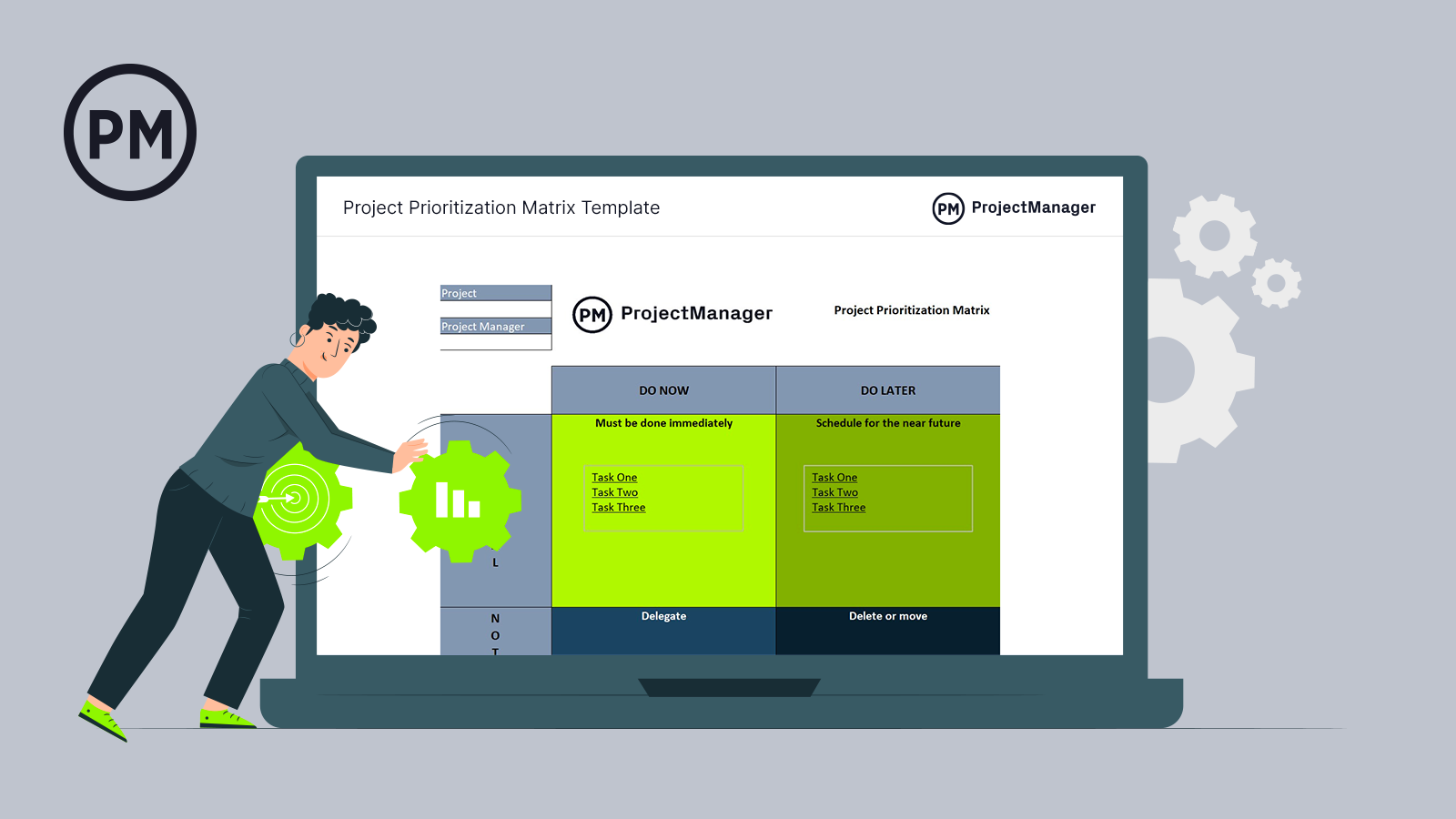
Get your free
Project Prioritization Matrix Template
Use this free Project Prioritization Matrix Template for Excel to manage your projects better.
Ideal for Organizations That Execute Projects Permanently
Construction companies, manufacturers and other businesses that are constantly going from one project to another can benefit from the project intake process. They’re always bidding on projects or having them submitted by clients. The project intake process can help them better choice which projects to initiate and which are better to pass on.
Provides Structure to Your Project Portfolio Management Process
As we said at the start of this section, having a structure for your project portfolio management process is what management is all about. The project intake process is one part of the larger whole that helps you do things better, otherwise it would just be chaotic.
Project Intake Criteria
The following are things that you should be looking out for when evaluating project requests that you get through an intake process.
- Strategic alignment: The request or project being considered must align with the long-term goals of the organization.
- Project scope & duration: Look over the specific goals, deliverables, tasks, costs and the deadline or duration of the project.
- Resource requirements and effort estimation: The resources, as in everything needed to complete the project, the effort involved need an accurate estimate.
- Resource capacity and availability: Look at your available resources and calculate the maximum amount of work that can be accomplished throughout the project or request.
- Expected project benefits: Forecast the return on investment or estimated revenue expected.
- Project risk analysis: Identify risks, both positive and negative, that might occur for the request or project being proposed.
- Cost-benefit analysis: Use this formula to estimate the costs of the request or project against the benefits it will provide.
What Are the Steps of the Project Intake Process?
Structure is the name of the game and that means that the project intake process should also be regimented and followed for every request or project being considered. Here are the basic steps to take to have a successful project intake process.
1. Create a Project Intake Form that Can Be Used to Write Project Requests
A project intake form is a document that collects information about the request or project being considered. The form answers questions, such as what is the project objective, who the stakeholders are, what’s the budget and the date of the project, among other details. This helps the PMO determine if the request fits into the strategic plans of the organization. A project intake form ensures consistency, streamlines communication and defines goals and more.
2. Use the Project Intake Criteria to Evaluate Project Requests
The above project intake criteria are the metric by which the PMO can measure the feasibility of the request. This will be reviewed by the project intake team, who assess the project proposal and will decide if it’s worth pursuing.
3. Approve Project Proposals and Allocate Resources
If the project being proposed meets the criteria, the next step is to approve it. Once approved, resources for that project will be allocated. This includes the project team and any materials, equipment, etc., required to complete the project.
4. Track the New Projects from Start to End
Once the project has been approved, the work is just beginning. The project team is responsible for executing the project and managing its day-to-day operations, but the PMO will be involved as well. They’ll monitor the project from start to finish and track various project metrics to ensure that the project is staying on schedule and not exceeding its budget.
Project Priority Matrix Template
This project prioritization matrix template helps you determine what projects need to be executed sooner depending on their level of effort, impact and urgency.
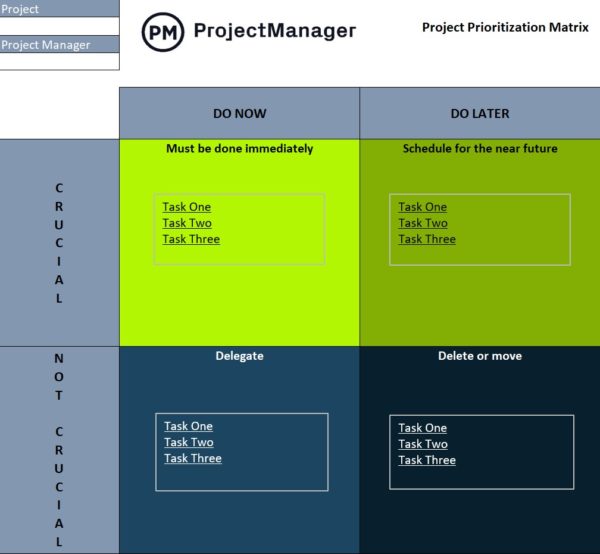
We offer a variety of free PMO templates you can use to manage all aspects of your projects, programs and portfolios.
What Should Be Included in a Project Intake Form?
We’ve talked about a project intake form and why it’s important to standardize the process. Let’s take a moment to explore the elements that should be included in a project intake form when proposing a new project.
Project Description
You’ll need to define the type of project that’s being proposed. This will help determine if the project is the right fit for the organization and if you have the resources needed to complete it. You’ll also be able to figure out if the deadline can be met and if there’s funding available to pay for the project.
Project Scope Overview
Again, the project scope is a critical part of the decision-making process and must be included on the project intake form. The project scope will help you set boundaries on the project and define what is in and out of scope. This allows you to better achieve the goals of the project and its objectives without delays and overspending.
Resource Requirements
The intake request form will also include resource requirements. Again, resources are everything needed to complete the project. That is human resources and nonhuman resources. To evaluate the project, you must know what the resource requirements are and if the organization has available resources to cover the project.
Estimated Project Duration
To know if the project can fit into the larger operation of your organization, you need to know how long it’ll take to complete. In other words, what’s the duration of the project? This will inform your resource allocation and budget.
Expected Project Benefits
Not to be forgotten in this process is the benefits the project will deliver to the organization. If the return on investment isn’t there, the other criteria on the intake form are moot. The point of any project is to serve the organization by increasing sales, revenue, market share, or some value. You must determine what that is.
Who Oversees the Project Intake Process?
Several different entities are responsible for the project intake process. It all depends on the type of organization that is doing the project intake process. Here are some examples of those who oversee the project intake process.
Business Decision Makers
In an organization that doesn’t have a PMO overseeing its projects, the people who will make the decisions regarding the project intake process are at the executive level. These are department managers, supervisors and other types of team leaders.
Project Portfolio Managers
Some organizations have project portfolio managers who oversee a portfolio of projects. They’re responsible for the high-level management of those projects and are in the best position to determine if any new projects are a good fit for the portfolio they manage.
Project Management Offices (PMOs)
As we’ve mentioned before, the PMO is responsible for managing the project intake process. A PMO is a governing body, either internal or external to the organization, which oversees the high-level management of its projects.
What Other Project Management Templates Can Help With the Project Intake Process?
ProjectManager is more than great project management software with portfolio features to help with project intake, we’re also an online hub for all things project management. For example, we have dozens of free project management templates for Excel and Word that can help you manage projects from start to finish. Here are a few to help with the project intake process.
Resource Plan Template
Resource requirements are a critical part of the project intake process. Our free resource plan template for Excel helps you list all your resources, their team, rates and costs. You can then allocate them over a weekly or monthly calendar.
Project Budget Template
Another consideration in the project intake process are costs. You can accurately estimate the price of your project with our free project budget template for Excel. It captures labor, materials, travel, equipment and more project costs, including tracking the actual expenditure.
Project Charter Template
A project charter will outline the reasons for initiating a project and, therefore, serve the project intake process. Our free project charter template for Word outlines all the information you’ll need to add, from the project definition to the project plan and more.
How ProjectManager Helps with Project Selection and Prioritization
Our free templates are a great way to start the project intake process, but as you move forward with project selection and prioritization you’ll find that they’re not sufficient to your project needs. That’s because templates are static documents that need to be manually updated and can slow down your project work. Project management software takes templates to the next level. ProjectManager is award-winning project management software with portfolio features that help you plan, manage and track projects in real time.
Track Project Costs Using Timesheets and Workload Charts
Being able to keep your human resources working at capacity and not negatively impacting the project budget is essential to delivering a successful project. You can track labor costs with our secure timesheets that not only streamline your payroll process but also give you transparency into how far each team member has gone in completing their tasks and the associated labor costs. To ensure that everyone is working at capacity, toggle over to the color-coded workload chart to easily see everyone’s allocation. You can then balance their workload by reallocating resources right from that chart.

Monitor Resources and Budgets with Real-time Dashboards
Another way to track your resources is with our real-time dashboards. They are always collecting real-time data from the project and displaying that information on easy-to-read graphs and charts that show costs, workload and more. You can get an instant status report whenever you need it. We also have a portfolio dashboard to give you a high-level view of all your projects in one place. Unlike lightweight dashboards that you’ll find in competitor’s products, we don’t require you to go through a lengthy and complicated setup process. Our live dashboard is ready when you are.
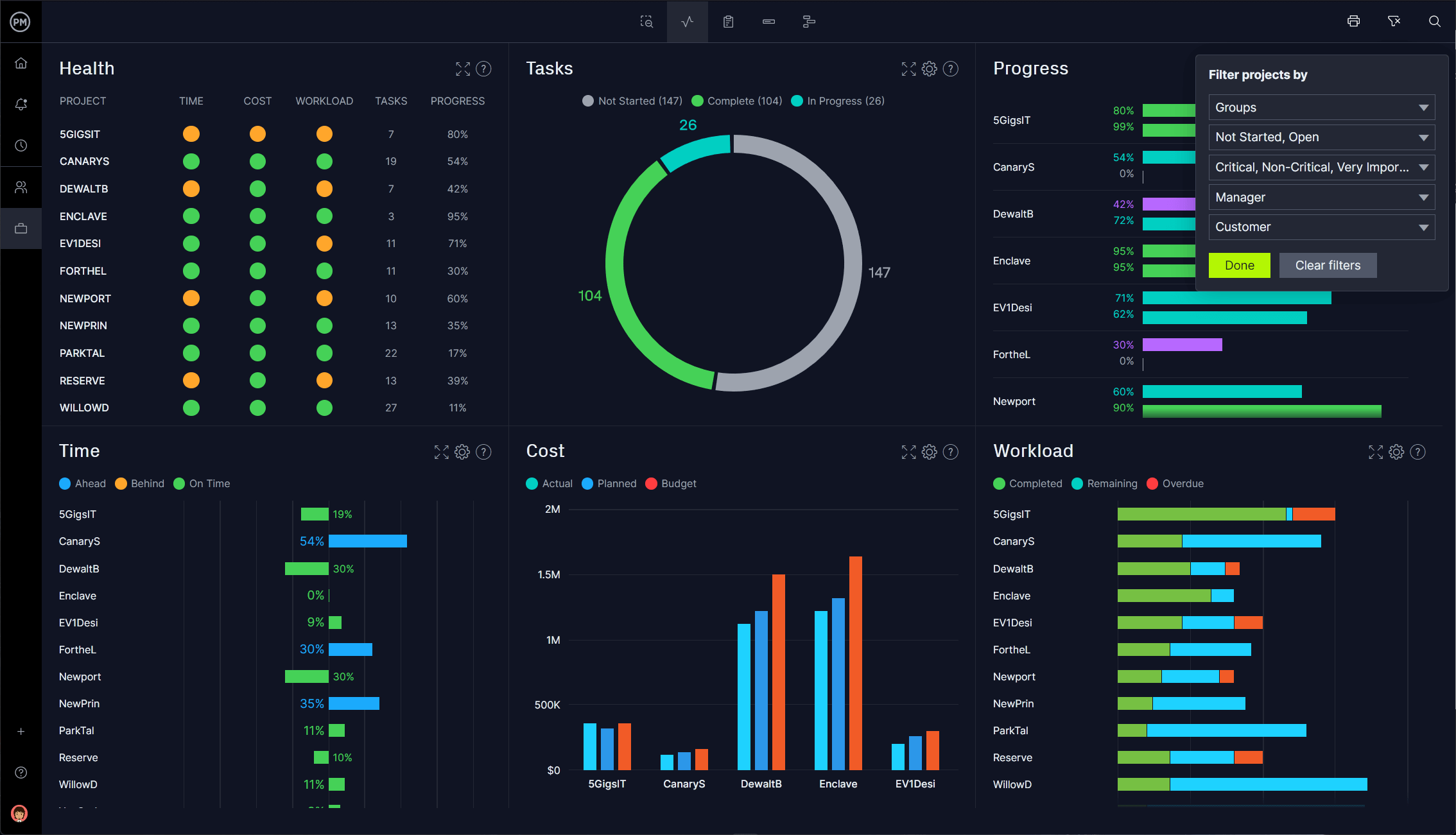
Other portfolio features we have include a roadmap, which is just like our Gantt chart only it tracks multiple projects on a shared visual timeline. This allows you to make better decisions on how to allocate resources across all your projects. You can also use our reporting tools, which are customizable and can be shared with stakeholders, to generate portfolios, workloads, timesheets and other reports.
ProjectManager is online project management software that connects teams whether they’re in the field, at their desk or anywhere in the world. They can share files, comment at the task level and stay updated with email notifications and in-app alerts. Join teams at companies, such as Avis, Nestle and Siemens, who use our software to deliver successful projects. Get started with ProjectManager today for free.

